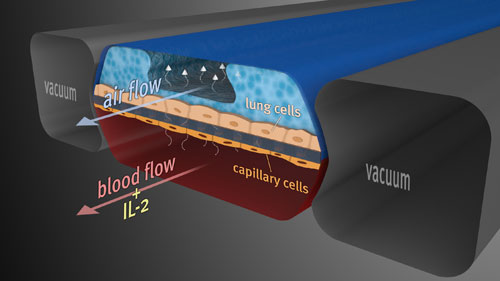EES is a leap forward for wearable technologies, and has potential applications ranging from medical diagnostics to video game control and accelerated wound-healing. Engineers John Rogers and Todd Coleman, who worked on the discovery, tell io9 it’s a huge step towards erasing the divide that separates machine and human.
Coleman and Rogers say they developed EES to forego the hard and rigid electronic “wafer” format of traditional electronics in favor of a softer, more dynamic platform.

To accomplish this, their team brought together scientists from several labs to develop “filamentary serpentine” (threadlike and squiggly) circuitry. When this circuitry is mounted on a thin, rubber substrate with elastic properties similar to skin, the result is a flexible patch that can bend and twist, or expand and contract, all without affecting electronic performance.
This video demonstrates the resilience of the EES patch, and how easily it can be applied. The patch (comprised of the circuitry and rubber substrate) is first mounted on a thin sheet of water-soluble plastic, then applied to the skin with water like a temporary tattoo.
How Will We Wear Our Second Skin? So what can an EES really do for us? The short answer is: a lot. In the paper describing their new technology, published in this week’s issue of Science, the researchers illustrated the adaptability of their concept by demonstrating functionality in a wide array of electronic components, including biometric sensors, LEDs, transistors, radio frequency capacitors, wireless antennas, and even conductive coils and solar cells for power.

We asked Rogers what he thought were the most promising applications for the new technology. He said medicine was the most compelling:
Our paper demonstrates our ability to monitor ECG (as a monitor of heart disease and metabolism), EMG (as a measure of, among other things, gait during walking) and EEG (as a measure of cognitive state and awareness).According to Rogers, the electronic skin has already been shown to monitor patients’ health measurements as effectively as conventional state-of-the-art electrodes that require bulky pads, straps, and irritating adhesive gels. “The fidelity of the measurement is equal to the best existing technology that is out there today, but in a very unique skin-like form,” he explained.
We have also shown that these same devices can stimulate muscle tissue to induce contractions. When combined with sensing/monitoring, such modes of use could be valuable in physical rehabilitation. We also have interest in sleep monitoring (for sleep apnea), and neo-natal care (monitoring premature babies, in particular).

What’s more, the electronic skin’s unique properties allow it to do things that existing biometric sensors simply can’t touch. Todd Coleman, who co-led the project with Rogers, told io9 how an EES could be applied to a person’s throat to serve as a communication aid:
Within the realm of biomedical applications, one can imagine providing benefits to patients with muscular or neurological disorders like ALS. For example, in the Science article, our research group used the device…to control a computer strategy game with muscles in the throat by speaking the commands.
In principle, the same function could have been achieved by simply mouthing commands rather than speaking them out loud. As such, this capability could be provided to ALS patients so that they could “speak” through an epidermal electronics system that is un-noticeable to them, and invisible to other observers.

Eroding the Distinction Between Machine and Human Outside the context of biomedicine, the EES’s inconspicuous nature opens up a whole world of possibilities. The patches are already barely noticeable, but when mounted directly onto a temporary tattoo, for example, any evidence of electronic circuitry disappears. Coleman said:
[This technology] provides a huge conceptual advance in wedding the biological world to the cyber world in a manner that is very natural. In some sense, the boundary between the electronics world and the biological world is becoming increasingly amorphous. The ramifications of this are mind-blowing, to say the least.
I envision endless applications that extend beyond biomedical applications. For example, we could use the exact same technology – and specifically its discrete tattoo-like appearance – to perform covert military operations where an agent could communicate to the command station with these electric signals without ever speaking a word.

Coleman’s statement touches on what is perhaps this most important thing about today’s announcement, namely the precedent it sets for future technologies that aim to combine the organismal with the synthetic.
“The blurring of electronics and biology is really the key point here,” said Northwestern University’s Yonggang Huang, with whom Rogers and Coleman collaborated. “All established forms of electronics are hard, rigid. Biology is soft, elastic. It’s two different worlds. This is a way to truly integrate them.”
Looking to the future, Rogers echoes his colleague’s sentiments. Describing what he envisions for his research group in the coming years, he said:
We would like to expand the functionality such that the devices not only seamlessly integrate with the human body in a mechanical sense, but that they also communicate and interact with the tissue in modes that go beyond electrons and photons (the ‘currency’ of semiconductor device technologies), to the level of fluids and biomolecules (i.e. the ‘currency’ of biology). We are hoping, in this way, to blur the distinction between electronics and the human body, in ways that can advance human health.Additional Reading Visit the Rogers Research Group at The University of Illinois at Urbana–Champaign Visit the Coleman Lab at UC San Diego
Rogers and Coleman’s research is published in tomorrow’s issue of Science and is also available online.
All images courtesy of John Rogers





















